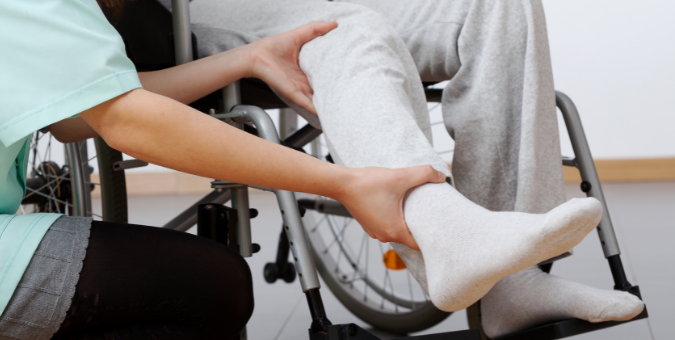
NICE Guideline 211, Rehabilitation after traumatic injury, is a framework laid out by The National Institute for Health and Care Excellence (NICE) to facilitate much-needed improvement in the outcomes for those who suffer a serious injury. Here, we take a detailed look at the rehabilitation guidelines and explore key questions.
What are the 2022 rehabilitation for traumatic injury NICE guidelines?
The 2022 NICE guidelines for traumatic injury set out how serious injuries should be treated, including:
- Spinal injuries
- Nerve injuries
- Musculoskeletal injuries
- Visceral injuries
- Soft tissue injuries
- Limb injuries.
The published guidelines include those for severe and moderate traumatic injuries, setting out best-practice guidelines for traumatic injury rehabilitation in both adults and children.
It outlines changes that could prove important for people who are in rehab for a traumatic injury, their families, and those who may suffer such a potentially life-changing injury in the future.
The key points include:
Initial assessment and early intervention
Initial assessment means keeping a closer eye on patients who have suffered a traumatic injury, so any brain injuries or problems with senses may be detected early.
Early intervention, meanwhile, means treating acute injuries as quickly as possible so patients can start their rehabilitation.
The NICE traumatic injury guidelines also argue rehabilitation needs should be thoroughly assessed at this early stage. This could help medics to meet their needs later in the process.
Multi-Disciplinary Team (MDT) rehabilitation needs assessment
The 2022 NICE traumatic injury rehabilitation guidelines express the need to assess patients across disciplines. This means someone who suffers a spinal injury might also receive an assessment from a social worker, for instance.
This recommendation aims to provide a comprehensive approach to needs assessment, which also includes a focus on patient engagement with the process. People who suffer traumatic injuries, especially to the brain, can often struggle with this aspect – so it is a welcome addition.
The committee that put the NICE recommendations together relied on their own knowledge and experience for this objective.
The importance of goal setting for rehabilitation
Goal setting is outlined as a key goal in the NICE guidelines for traumatic injury rehabilitation, giving both professionals and patients a scenario to aim for.
Having a defined set of goals to strive for can help to stop patients from feeling overwhelmed by the rehabilitation process. The committee felt it was important that this be formalised into the guidelines.
The rehabilitation plan
A rehabilitation plan provides the roadmap for a patient’s recovery from their traumatic injury.
Because progress needs to be consistent, this recommendation also states that, if the patient’s own multi-disciplinary team won’t be able to help them in time, they should make a referral elsewhere so that the momentum of recovery isn’t lost.
Communication and collaboration in the rehabilitation process
These rehabilitation guidelines are intended to make sure patients receive clear communication about their injury, how it will affect their needs and what goals they should strive for as part of their rehabilitation.
The idea is also to ensure that multi-disciplinary teams are working in a way that supports the rehabilitation journey of their patients.
Coverage of physical and psychological rehabilitation needs
These are recommendations about the planning, commissioning and coordination of rehabilitation and related services, and the design of the care pathways which plot their delivery.
The 2022 NICE guidelines state these should be broad ranging, covering both physical and psychological work. For instance, someone who has faced a life-changing injury might benefit from psychological treatments to come to terms with this.
How have the guidelines for traumatic injury rehabilitation changed over time?
The 2022 NICE traumatic injury rehabilitation guidelines lay out some important changes, but this isn’t the first time that rehabilitation within the NHS has been reviewed.
In 2010, the Clinical Advisory Group (CAG) produced a report to advise on a patient-focused approach intended to improve services and outcomes for patients suffering from major trauma.
It was recognised then that rehabilitation had usually been either a closing recommendation, or worse, simply ignored.
In 2010, the CAGs recommended that improving traumatic injury rehabilitation should be given more priority. Some of the biggest considerations informing trauma care pathway redesign were said to be:
- The need to improve both acute and specialist rehabilitation
- The crucial role of community or generalist rehabilitation.
The report raised a number of recommendations to improve rehabilitation services and outcomes.
It led to the introduction of the rehabilitation prescription, which would be provided to all trauma patients with identified needs. The rehabilitation prescription described the patient’s physical, cognitive and psycho-social needs in the context of their pre-injury life, and was designed to state how these needs would be addressed.
The prescription would be an extension of a discharge or transfer summary and would include ongoing health and social care plans.
As a result, major trauma centres (MTCs) were born, with the first opening in England in 2012.
What is the future of personal injury rehabilitation?
In spite of the changes, some obstacles to outcomes for patients suffering traumatic injury have persisted. With the NHS ever more stretched because of COVID-19, there is more pressure than ever on teams to deliver.
The new guidelines from NICE certainly provide a broader perspective, and it is welcome to see that rehabilitation after traumatic injury is being looked at in terms of communication and collaboration.
That said, we cannot be certain how the guidelines will play out – for instance, if the resources will be in place so this can be delivered in the best way for those who have suffered traumatic injury.
In the future, NHS provision may be combined with private provision funded by insurance companies to maximise rehabilitation efforts. This may help give individuals who suffer traumatic injury a chance to regain the quality of life they had pre-injury.
Traumatic injury guidelines: Key questions.
What is considered a traumatic injury?
Atraumatic injury is an injury that happens suddenly and needs immediate medical attention – in severe cases, it might threaten life or lead to long-term disability. According to NICE, this can also be a combination of injuries.
Common types of traumatic injury include:
- Traumatic brain injury
- Spinal cord damage or spine fractures
- Severe cuts or impact to the face
- Skull fractures
- Broken bones
- Puncture wounds
- Burns and electrical injury.
What are the NICE guidelines for traumatic brain injury rehab?
Traumatic brain injury has its own specific set of NICE rehabilitation guidelines, released in 2014. These set out care measures for people with new cognitive, emotional, behavioural or physical problems that continue for at least 72 hours after an injury to the brain.
The traumatic brain injury treatment guidelines champion:
- Timely CT scans and cervical spine scans
- Written radiology reports
- Access to a specialist neuroscience unit for patients with a low Glasgow Coma Scale (GCS) score
- Inpatient rehabilitation
- Community-based neuro-rehabilitation for further support.
What are psychological approaches to rehabilitation after traumatic injury?
Traumatic injury rehabilitation often goes hand in hand with personal approaches, including psychological and vocational rehab. NICE recommends that healthcare staff should facilitate immediate psychological support for people who are distressed after such an injury, as well as people whose thinking appears to be impaired. This assessment can sometimes feed into occupational therapy, speech therapy and wider social support systems to give the patient the best possible shot at recovery.


















